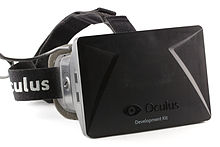Virtual reality (VR) is a computer-generated scenario that simulates a realistic experience. The immersive environment can be similar to the real world in order to create a lifelike experience grounded in reality or sci-fi. Augmented reality systems may also be considered a form of VR that layers virtual information over a live camera feed into a headset, or through a smartphone or tablet device.
VR systems that include transmission of vibrations and other sensations to the user through a game controller or other devices are known as haptic systems. This tactile information is generally known as force feedback in medical, video gaming and military training applications.
Technology.
The Virtual Reality Modelling Language (VRML), first introduced in 1994, was intended for the development of
"virtual worlds" without dependency on headsets. The Web3D consortium was subsequently founded in 1997 for the development of industry standards for web-based 3D graphics. The consortium subsequently developed X3D from the VRML framework as an archival, open-source standard for web-based distribution of VR content.
All modern VR displays are based on technology developed for smartphones including: gyroscopes and motion sensors for tracking head, hand, and body positions; small HD screens for stereoscopic displays; and small, lightweight and fast processors. These components led to relative affordability for independent VR developers, and lead to the 2012 Oculus Rift kickstarter offering the first independently developed VR headset.[7]
Independent production of VR images and video has increased by the development of omnidirectional cameras, also known as 360-degree cameras or VR cameras, that have the ability to record in all directions, although at low-resolutions or in highly compressed formats for online streaming.[8] In contrast, photogrammetry is increasingly used to combine several high-resolution photographs for the creation of detailed 3D objects and environments in VR applications.
History
Before the 1950s
Laurence Manning's 1933 series of short stories, "The Men Who Awoke"—later a novel—describes a time when people ask to be connected to a machine that replaces all their senses with electrical impulses and, thus, live a virtual life chosen by them (à la "The Matrix", but voluntary, not imposed).The exact origins of virtual reality are disputed, partly because of how difficult it has been to formulate a definition for the concept of an alternative existence.[11] Elements of virtual reality appeared as early as the 1860s. French avant-garde playwright Antonin Artaud took the view that illusion was not distinct from reality, advocating that spectators at a play should suspend disbelief and regard the drama on stage as reality.[12] The first references to the more modern concept of virtual reality came from science fiction.
Stanley G. Weinbaum's 1935 short story "Pygmalion's Spectacles"[13]describes a goggle-based virtual reality system with holographic recording of fictional experiences, including smell and touch.
1990–2000
In 1991, Carolina Cruz-Neira, Daniel J. Sandin and Thomas A. DeFanti from the Electronic Visualization Laboratorycreated the first cubic immersive room, The Cave. Developed as Cruz-Neira's PhD thesis, it involved a multi-projected environment, similar to the holodeck, allowing people to see their own bodies in relation to others in the room.
In 1992 researcher Louis Rosenberg created the Virtual Fixtures system at the U.S. Air Force’s Armstrong Labs using a full upper-body exoskeleton, enabling a physically realistic virtual reality in 3D. The system enabled the overlay of physically real 3D virtual objects registered with a user's direct view of the real world, producing the first true augmented reality experience enabling sight, sound, and touch.
2000–2015
In 2001, SAS3 or SAS Cube became the first PC based cubic room, developed by Z-A Production (Maurice Benayoun, David Nahon), Barco, Clarté, installed in Laval France in April 2001. The SAS library gave birth to Virtools VRPack. By 2007, Google introduced Street View, a service that shows panoramic views of an increasing number of worldwide positions such as roads, indoor buildings and rural areas. It also features a stereoscopic 3D mode, introduced in 2010.
In 2013, Valve discovered and freely shared the breakthrough of low-persistence displays which make lag-free and smear-free display of VR content possible.] This was adopted by Oculus and was used in all their future headsets.
First model of VR was invented in 2013

2013 developer version of VR
MODERN VR GLASSES
(2015-2017)
By 2016 there were at least 230 companies developing VR-related products. Facebook has 400 employees focused on VR development; Google, Apple, Amazon, Microsoft, Sony and Samsung all had dedicated AR and VR groups. Dynamic binaural audio was common to most headsets released that year. However, haptic interfaces were not well developed, and most hardware packages incorporated button-operated handsets for touch-based interactivity. Visually, displays were still of a low-enough resolution and frame-rate that images were still identifiable as virtual. On April 5, 2016, HTC shipped its first units of the HTC VIVE SteamVR headset. This marked the first major commercial release of sensor-based tracking, allowing for free movement of users within a defined space.
In early 2017, a patent filed by Sony showed they were developing a similar location tracking technology to the VIVE for PlayStation VR, with the potential for the development of a wireless headset.

